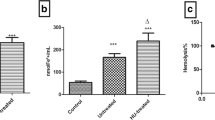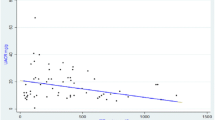Abstract
Changes in red blood cell (RBC) lipid peroxidation [measured by malonyl dialdehyde (MDA) concentration], glutathione (GSH) metabolism, antioxidant enzyme activities (catalase, superoxide dismutase, glutathione peroxidase) and haemoglobin (Hb) metabolites (metHb, carboxy Hb) were studied in six children with post-enteropathic (D+) haemolytic uraemic syndrome (HUS) and ten controls. The in vitro effect of hydrogen peroxide [acetyl-phenylhydrazine (APH) test] on GSH and Hb metabolism was also investigated. MDA levels were significantly higher and the antioxidant enzyme activities were lower in HUS patients than in the controls (P<0.01). The oxidised glutathione concentration was significantly higher in the patients than in the control children (26.3±12.6 vs. 10.9±1.8 nmol/g Hb. Percentage values of carboxy Hb and metHb were also higher in HUS (P<0.01). Incubation of RBC with APH induced a more pronounced decrease in the concentration of GSH (P<0.001) and a significant increase (P<0.01) in the level of metHb and carboxy Hb in the HUS patients. This suggests that there is reduced RBC GSH stability in HUS. Utilisation of GSH and antioxidant enzymes leads to increased Hb oxidation and haemolysis. The oxidative damage may have an important role in the pathogenesis of haemolytic anaemia in HUS.
Similar content being viewed by others
References
Nafstad I (1974) Endothelial damage and platelet thrombosis associated with PUFA-rich, vitamin E deficient diet fed to pig. Thromb Res 5:251–255
Teige J, Nordstoga K, Fjolstad M, Nafstad I (1973) The generalized Schwartzman reaction in pigs induced by diet and single injection of endotoxin fromEscherichia coli. Acta Vet Scand 14:92–106
Kaplan BS, Mills M (1988) Elevated serum elastase and alpha-1-antitrypsin levels in hemolytic uremic syndrome. Clin Nephrol 30:193–196
Milford D, Taylor CM, Rafaat F, Halloran E, Dawes J (1989) Neutrophil elastases and haemolytic uraemic syndrome (letter). Lancet 2:1153
Fitzpatrick MM, Shah V, Filler G, Dillon MJ, Barratt TM (1992) Neutrophil activation in the haemolytic uraemic syndrome: free and complexed elastase in plasma. Pediatr Nephrol 6:50–53
Neild G (1992) Haemolytic uraemic syndrome (including disseminated intravascular coagulation and thrombotic thrombocytopenic purpura), In: Cameron S, Davison AM, Grunfeld J-P, Kerr D, Ritz E (eds) Oxford textbook of clinical nephrology. Oxford University Press, Oxford, pp 1041–1060
Forsyth KD, Simpson AC, Fitzpatrick MM, Barratt TM, Levinsky RJ (1989) Neutrophil-mediated endothelial injury in haemolytic uraemic syndrome. Lancet 2:411–414
Walters MD, Matthei IU, Kay R, Dillon MJ, Barratt TM (1989) The polymorphonuclear leucocyte count in childhood haemolytic uraemic syndrome. Pediatr Nephrol 3:130–134
Tietze F (1969) Enzymic method for quantitative deterioration of nanogram amounts of total and oxidized glutathione: application to mammalian blood and other tissues. Anal Biochem 27:502–522
Akerboom TPM, Sies H (1981) Assay of glutathione, glutathione, disulphide and glutathione mixed disulphides in biological samples. Methods Enzymol 77:373–382
Guntherberg H, Rapaport S (1968) Eine Methode zur Bestimmung des oxydierten Glutathions. Acta Biol Med Germ 20:559–564
Beutler E (1957) The glutathione instability of drug-sensitive red cells. A new method for the in vitro detection of drug sensitivity. J Lab Clin Med 49:84–95
Matkovics B, Novak Z, Hoang DH, Szabo L, Vargha SJ, Zalesna G (1987) A comparative study on some important experimental animal peroxide metabolism enzymes. Comp Biochem Physiol [β] 56:31–34
Misra HP, Fridovich I (1972) The role of superoxide anion in the antioxidation of epinephrine and a simple assay for superoxide dismutase. J Biol Chem 247:3170–3175
Sedlak I, Lindsay RH (1968) Estimation of total, protein-bound and nonprotein sulphydryl groups in tissue with Ellman's reagent. Anal Biochem 25:192–205
Chin DTY, Stults FH, Tappal AL (1976) Purification and properties of rat lung soluble glutathione peroxidase. Biochim Biophys Acta 445:558–566
Placer ZA, Cusman L, Johnson BC (1966) Estimation of product of lipid peroxidation by malonyl dialdehyde in biochemical systems. Anal Biochem 16:359–364
Turi S, Nemeth I, Vargha I, Matkovics B, Dobos E (1991) Erythrocyte defence mechanisms against free oxygen radicals in haemodialysed uraemic children. Pediatr Nephrol 5:179–183
Lowry OH, Rosebrough NI, Farr AL, Randal R (1951) Protein measurement with the folin phenol reagent. J Biol Chem 193:265–275
Brown RE, Alade SL, Knight JA, Evans BJ (1988) Serum lipoperoxidation products in an infant with hemolytic-uremic syndrome. Clin Chem 34:2382–2384
Situnayake RD, Crump NJ, Turnham DI, Taylor CM (1991) Further evidence of lipid peroxidation in post-enteropathic haemolytic-uraemic syndrome. Pediatr Nephrol 5:387–392
O'Regan S, Chesney RW, Kaplan BS, Drummond KN (1981) Red cell membrane phospholipid abnormalities in the hemolytic uremic syndrome. Clin Nephrol 15:14–17
Cordes EH, Jencks WP (1962) On the mechanism of Schiff base formation and hydrolysis. J Am Chem Soc 84:832–837
Knight JA, Smith SE, Kinder VE, Anstall HB (1987) Reference intervals for plasma lipoperoxides: age-, sex-, and specimen-related variations. Clin Chem 33:2289–2291
Janero DR (1990) Malondialdehyde and thiobarbituric acid reactivity as diagnostic indices of lipid peroxidation and peroxidative tissue injury. Free Radic Biol Med 9:515–540
Hochstein P, Jain SR (1981) Association of lipid peroxidation and polymerization of membrane proteins with erythrocyte aging. Physiological significance of lipid peroxidation. Fed Proc 40:183–188
Boca Raton (1985) Pathological states. In: Oberley LW (ed) Superoxide dismutase, vol 3. CRC Press, New York, pp 151–236
Powell HR, McCredie DA, Taylor CM, Burke JR, Walker RG (1984) Vitamin E treatment of haemolytic uraemic syndrome. Arch Dis Child 59:401–404
Aggarwal SK, Saini AS (1984) Formation and detoxification of oxygen free radicals and peroxides in erythrocytes. Indian J Haematol 2:39–44
Costagliola C, Libondi T, Menzione M, Rinaldi E, Aurichio G (1985) Vitamin E and red blood cell glutathione. Metabolism 34:712–714
Costagliola C, Menzione M, Romano L (1987) Oxidative state of glutathione in arterial and venous red blood cells and plasma of rabbit. Eur J Haematol 38:327–330
Jocelyn PC (1972) Biochemistry of the SH groups. Academic Press, London, p 247
Eggleston LV, Krebs HA (1974) Regulation of the pentose phosphate cycle. Biochem J 138:425–435
Szebeni J, Winterbourn CC, Carrell RW (1984) Oxidative interactions between haemoglobin and membrane lipid. A liposome model. Biochem J 220:685–692
Longo LD (1977) The biological effects of carbon monoxide on the pregnant woman, fetus and newborn infant. Am J Obstet Gynecol 129:59–102
Bolande PP, Kaplan BS (1985) Experimental studies on the hemolytic-uremic syndrome. Nephron 39:228–236
Moncada S, Gryglewski RJ, Bunting S, Vane JR (1976) A lipid peroxide inhibits the enzyme in blood vessel microsomes that generates from prostaglandin endoperoxides the substance (prostaglandin X) which prevents platelet aggregation. Prostaglandins 12: 715–737
Túri S, Beattie TJ, Belch JJF, Murphy AV (1986) Disturbances of prostacyclin metabolism in children with haemolytic uraemic syndrome and in first degree relatives. Clin Nephrol 25:193–198
Author information
Authors and Affiliations
Rights and permissions
About this article
Cite this article
Túri, S., Németh, I., Vargha, I. et al. Oxidative damage of red blood cells in haemolytic uraemic syndrome. Pediatr Nephrol 8, 26–29 (1994). https://doi.org/10.1007/BF00868253
Received:
Revised:
Accepted:
Issue Date:
DOI: https://doi.org/10.1007/BF00868253




